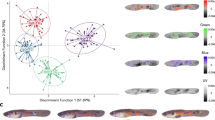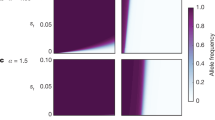Abstract
WERRET et al.1 described a series of matings, starting with a non-silver male resulting from a cross of a Brown Leghorn sire by a Light Sussex dam, which suggested that the gene for silver (S) had mutated to that for semi-albinism, designated by them as sal. As the mutant gene also proved to be recessive to that for gold (s), together they formed a series of three alleles at one locus on the sex chromosome. Mueller and Hutt2 first described imperfect or semi-albinism (al), and afterwards Hutt3 reported on the linkage relationships of his al to other genes on that chromosome. Although Hutt had no specific tests of linkage of al with S, both these genes were tested with others located nearby. Identical linkages (0.7 per cent) were found with the gene for dwarf (dw) ; but for the gene for rapid feathering (k), where there were more gametes tested and the map distance was considerably less, k was closer (1.6 per cent) to al than to S (2.8 per cent), a situation that did not suggest possible allelism. Hutt therefore placed al between S and k, a little closer (1.2 per cent) to the former.
This is a preview of subscription content, access via your institution
Access options
Subscribe to this journal
Receive 51 print issues and online access
$199.00 per year
only $3.90 per issue
Buy this article
- Purchase on Springer Link
- Instant access to full article PDF
Prices may be subject to local taxes which are calculated during checkout
Similar content being viewed by others
Change history
01 August 1964
In the communication entitled "Allelism of Silver, Gold, and Imperfect Albinism in the Fowl" by Prof. K. K. Cole and T. K. Jeffers, which appeared on p. 1238 of the December 31, 1963, issue of Nature, lines 13 and 14 should read ". . . Identical linkages (7?0 per cent) were ...?.
References
Werret, W. F., Candy, A. J., King, J. O. L., and Sheppard, P. M., Nature, 184, 480 (1959).
Mueller, C. D., and Hutt, F. B., J. Heredity, 32, 71 (1941).
Hutt, F. B., Heredity, 15, 97 (1960).
Hutt, F. B., and Mueller, C. D., Amer. Naturalist, 77, 181 (1943).
Cole, R. K., J. Heredity, 52, 47 (1961).
Jaap, R. G., Poultry Sci., 35, 490 (1956).
Author information
Authors and Affiliations
Rights and permissions
About this article
Cite this article
COLE, R., JEFFERS, T. Allelism of Silver, Gold, and Imperfect Albinism in the Fowl. Nature 200, 1238–1239 (1963). https://doi.org/10.1038/2001238a0
Issue Date:
DOI: https://doi.org/10.1038/2001238a0
Comments
By submitting a comment you agree to abide by our Terms and Community Guidelines. If you find something abusive or that does not comply with our terms or guidelines please flag it as inappropriate.



